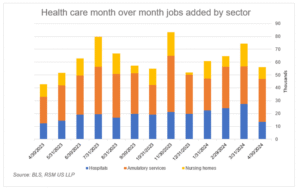Healthcare Job Growth is accelerating. See healthcare employment trends 2025, nursing job demand, and the future of allied health careers with real stats and insights.
Healthcare job growth does more than stay steady. It reshapes the U.S. labor market. From clinical care to health IT and revenue cycle, this sector adds jobs faster than most parts of the economy.
In 2023, healthcare added 654,000 jobs. It made up nearly a quarter of all new U.S. jobs. The outlook through 2032 to 2035 still looks strong.
In this guide, we break down healthcare employment trends for 2025 and beyond. You will see what grows, why it grows, and where demand runs strongest.
We cover nursing job demand, the future of allied health careers, and the quick rise of non-clinical roles like health IT, analytics, and marketing.
Healthcare Employment Trends for 2025: What Fuels the Surge
Healthcare now employs more than 17.4 million people. Growth in 2023 hit a 30-year high. It rose 3.9 percent, compared to 1.5 percent in other industries. Early 2024 kept that pace. It added more than 70,000 jobs in January.
Three big drivers stand out.
- Catch-up care after pandemic delays. Elective procedures returned. This boosted hiring in hospitals and outpatient care.
- Population aging. More chronic disease means more long-term conditions and more primary care demand.
- Shift to ambulatory care. Outpatient visits and same-day procedures rise. Ambulatory hiring grew about 9.6 percent since the pandemic. In 2023, it averaged more than 26,000 jobs per month.
Not every setting grows. Nursing homes and residential care facilities stay below pre-pandemic employment levels due to closures and lower census. But overall, the sector keeps adding roles across care delivery and operations.

SEE ALSO: Tips for Job Hunting in the USA: 2025 Guide for Graduates, Immigrants, and Career Changers
Healthcare Employment Trends for 2025 by Setting and Role
Care moves closer to the patient. Work spreads across many specialties and support functions. Here is how it breaks down.
Ambulatory and Outpatient Care Lead the Way
Outpatient surgery centers, physician offices, retail clinics, and home-based services expand.
- Patients prefer convenience and lower costs when safe.
- Payers push site-of-care shifts where possible.
- Expect steady growth in medical assistants, diagnostic techs, primary care providers, and behavioural health in these settings.
Hospitals Recover with Focused Hiring
Hospital employment rose roughly 3.7 percent from pre-pandemic levels.
- Demand stays strong in emergency, med-surg, critical care, perioperative, and imaging.
- Workforce strategy focuses on smarter staffing, floating pools, and technology that cuts administrative burden.
Long-Term and Residential Care Still Lag
Employment remains below pre-pandemic levels.
- Causes include facility closures, staffing shortages, and budget pressures.
- Policy changes and alternative senior care models may shift how these roles develop in the next few years.
Nursing Job Demand: Persistent, Diversified, and Evolving
Nursing remains the backbone of healthcare job growth. But the shape of demand changes.
Registered Nurses (RNs) and Licensed Practical/Vocational Nurses (LPN/LVNs)
RNs fill needs across hospitals, ambulatory surgery centers, primary care, home health, and telehealth triage.
- LPN/LVN roles expand in outpatient clinics, long-term care, and home services.
- Burnout and turnover affect nurses. Median nurse tenure fell about 20 percent between 2021 and 2022.
- Facilities invest in flexible scheduling, preceptors, internal staffing marketplaces, and on-the-job upskilling.
Advanced Practice Registered Nurses (APRNs: NPs, CRNAs, CNMs)
Nurse practitioners see strong demand in primary care, urgent care, mental health, and women’s health.
- In many states, NPs practice with high autonomy. This improves access and throughput.
- CRNAs stay vital in anesthesia care as surgical volumes rebound.
Practical Steps Employers Take to Attract and Retain Nurses
- Streamline documentation to reclaim clinical time.
- Increase internal mobility and residency pathways.
- Offer part-time, weekend, or seasonal staffing tracks to reduce burnout.
- Add tech that supports rather than interrupts clinical flow.
The Future of Allied Health Careers: Where Growth Runs Strongest
Allied health roles rise fast. Aging populations, rehab needs, and diagnostics drive this. Many careers offer solid pay with associate’s or bachelor’s degree. They make attractive entry points.

Top Expanding Allied Health Roles
Here are highlights from BLS-based outlooks and past handbooks. Local growth varies by region and setting.
- Home Health Aides and Personal Care Aides
What they do: Assist with daily living, basic health tasks under supervision, and support independent living.Why growing: Aging in place, home-based recovery, and payer incentives to reduce hospital stays.
Pathways: Short training; strong entry point into healthcare.
- Occupational Therapy Assistants and Aides
What they do: Support OTs with daily living skills training, adaptive equipment use, and rehab programs.Why growing: Rehab needs after surgery or illness; pediatric and neurodevelopmental support.
Pathways: Associate’s degree or certificate for assistants; aides often require on-the-job training.
- Physical Therapist Assistants and Aides
What they do: Help patients regain mobility and manage pain; prep therapy areas; document progress.Why growing: Post-op rehab, chronic disease management, and fall prevention programs.
Pathways: Associates for assistants; aides typically need non-degree training.
- Diagnostic Medical Sonographers and Cardiovascular Technologists
What they do: Imaging for organs, blood flow, cardiac function; support surgeons and physicians with diagnostics.Why growing: Imaging-first diagnostics, non-invasive tools, and outpatient procedure growth.
Pathways: Associate’s degree; strong salary and steady demand.
- Phlebotomists
What they do: Draw blood for labs, donations, and research.Why growing: Lab testing volumes remain high in outpatient and hospital settings.
Pathways: Post-secondary certificate; quick path to employment.
- Medical Assistants
What they do: Front-and-back office support, vitals, EHR updates, scheduling, and rooming.Why growing: Physician practices and outpatient centers rely on MAs to maintain throughput.
Pathways: Post-secondary certificate; bridge to many other roles.
- Surgical Technologists
What they do: Prepare ORs, maintain sterile fields, support surgeons intra-op.Why growing: Surgical backlogs clear, ambulatory surgery center growth.
Pathways: Post-secondary certificate; hands-on OR environment.
- Audiologists, Optometrists, Physical Therapists, and Orthotists/Prosthetists
These require advanced training but remain strong growth areas due to aging, chronic disease, and mobility or sensory needs.
Tip for candidates: Match your training plan to your preferred setting. If you want outpatient predictability, look at imaging and medical assistant roles. If you love fast pace, consider surgical tech or ER-focused pathways.
Non-Clinical Growth: Healthcare IT, Analytics, Revenue Cycle, and Digital
The fastest-growing corner might surprise you. Non-clinical functions boom. Health systems need people to run modern tech stacks, manage finances, and improve the patient experience.
Health IT and Data Roles Boom
Why: Nearly every system modernizes EHRs, ERPs, HCM, CRM, and patient-facing platforms.
- In-demand platforms: Epic, Oracle Health, Cerner, Meditech, Workday, Salesforce, and integration/middleware tools.

Hot roles:
- Software developers and integration engineers
- Data analysts, clinical informaticists, BI developers
- Systems admins and cloud engineers
- Cybersecurity specialists
- Telehealth support and product ops
A recent snapshot from industry staffing data shows:
- 46 percent of technology placements were contract roles; 54 percent permanent.
- Remote-first is common; many roles do not require on-site presence.
- Hiring managers prioritize platform experience, data skills, and security awareness.
Revenue Cycle and Administrative Hiring Stays Hot
Why: Hospitals operate on thin margins; efficient billing and collections keep lights on.
The global revenue cycle management (RCM) market should surpass $270 billion by 2030.
Key functions:
- Patient registration and insurance verification
- Claims submission, denials management, and appeals
- Patient billing and financial counselling
- Compliance and audit readiness
- RCM analytics and KPI reporting
Hiring patterns:
- Many placements are contract or contract-to-hire to handle surge projects or system upgrades.
- Communication, organization, and multitasking rank as top soft skills for administrative roles.
Marketing, Digital, and Creative Talent Matter More Each Year
Why: Competition for patients, more consumer choice, and a push for better digital experiences.
In-demand skills:
- UX/UI for telehealth and patient portals
- Content strategy to explain complex conditions in plain language
- Brand and service line marketing
- Product design for patient wearables and devices
Remote and hybrid models let systems source specialized talent nationwide. Local clinical teams stay focused on care.
Why Healthcare Job Growth Lasts Long, and What Could Slow It
Demand Tailwinds
- Aging demographics increase utilization across primary care, specialty care, diagnostics, and rehab.
- Chronic disease prevalence requires ongoing care and monitoring.
- Policy and payer trends shift more care to lower-cost settings.
Operational and Workforce Headwinds
- Burnout and turnover pressure staffing budgets. Up to 70 percent of healthcare workers report high stress.
- Some facilities struggle to maintain margins; personnel costs are the biggest lever.
- Long-term care faces staffing shortages and reimbursement constraints.
How Organizations Adapt
- Better workforce planning and flexible staffing (internal float pools, gig-like shifts).
- Automation and AI remove admin friction rather than add it.
- Career pathways, tuition support, and upskilling to retain talent.
- Experience design improves both clinician and patient journeys.
Top 5 Fastest-Growing Healthcare Role Clusters to Watch
- Home- and Community-Based Care
Home health aides, personal care aides, visiting nurses, community health workers - Outpatient Diagnostics and Therapies
Sonography, cardiovascular techs, lab and imaging, PT/OT assistants - Primary and Behavioural Care Expansion
Nurse practitioners, physician assistants, counsellors, and social workers - Health IT and Data
EHR/ERP analysts, data engineers, cybersecurity, and telehealth product teams - Revenue Cycle and Operations
Patient access, coding, billing, denials, financial counselling, RCM analytics
Skills That Boost Your Healthcare Career in 2025
Patient-Facing Roles
- Strong communication and empathy
- Documentation/EHR fluency without slowing care
- Team collaboration across settings
Allied Health
- Hands-on technical skills (imaging, modalities, rehab protocols)
- Safety and infection control
- Clear patient education
Health IT and Data
- SQL, BI tools, dashboarding
- Security awareness and privacy compliance
- Platform certifications (Epic, Oracle, Workday, Salesforce)
Revenue Cycle and Admin
- Detail orientation and process accuracy
- Payer rules and claims workflows
- Analytics literacy and KPI tracking
Marketing and Digital
- Plain-language health storytelling
- UX methods for portals and telehealth
- Content operations and service line campaigns
Regional and Setting Differences You Should Expect
Metro areas with large health systems and academic medicine grow faster across specialties and IT.
- Outpatient clusters thrive in suburbs and fast-growing regions due to new clinics and surgery centers.
- Rural areas see steady demand but face bigger hiring challenges; telehealth and travelling clinicians help fill gaps.
- Long-term care hiring varies by state policy and facility closures.
If you pick a career path, map local demand to your education plan. Use regional job boards and system career pages to see what is hot near you.
The Near-Term Outlook for Healthcare Employment
The U.S. Chamber of Commerce expects over 3.3 million new jobs in the next seven years across healthcare and pharma.
- BLS projections suggest healthcare could account for roughly 45 percent of all job gains from 2022 to 2032.
- Ambulatory growth and non-clinical expansion remain the story, even as hospitals stabilize.
- Retention is the wildcard. Systems that improve schedules, workflows, and career paths will win.
FAQs on Healthcare Job Growth
Is Healthcare Still a Good Career Bet?
Yes. Demand runs broad. Even with pockets of challenge, the long-term drivers last.
Do I Need a Four-Year Degree to Enter Healthcare?
Not always. Many allied roles use associate’s degrees or post-secondary certificates. You can ladder up over time.
Can I Work in Healthcare If I’m Not Clinical?
Absolutely. Health IT, analytics, cybersecurity, revenue cycle, marketing, and operations all hire.
What If I’m Worried About Burnout?
Look for outpatient settings, four-day weeks, or roles with predictable schedules. Ask about documentation burden, team support, and staffing ratios in interviews.
Conclusion: Healthcare Job Growth Runs Broad, Tech-Enabled, and Here to Stay
Healthcare job growth stands as one of the strongest forces in the U.S. labour market. The mix changes fast: more outpatient care, more allied roles, and a big rise in non-clinical jobs that power modern health systems.
Nursing job demand stays high, but success depends on retention, flexible staffing, and smarter tech. The future of allied health careers looks solid, especially in diagnostics and rehab. Health IT, data, revenue cycle, and marketing now play essential roles for access, quality, and margin.
If you want in, a path exists at almost every education level. If you are already in, upskilling in data, platforms, or patient experience can lift your career. Either way, the next decade favours people who combine care, tech, and clear communication.






